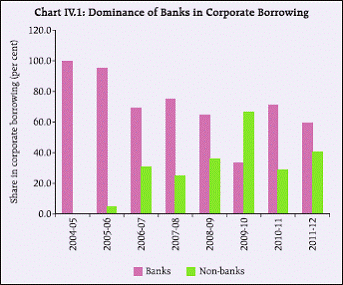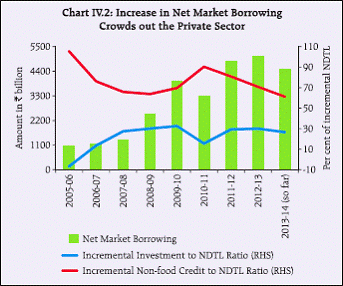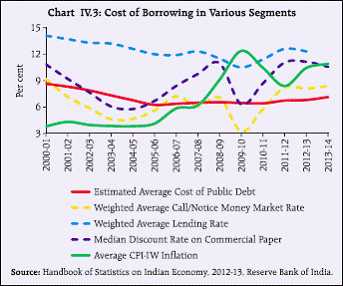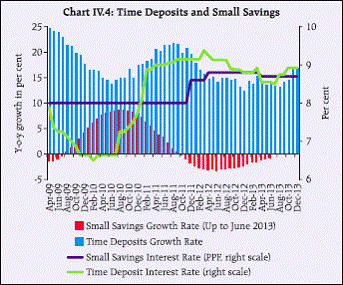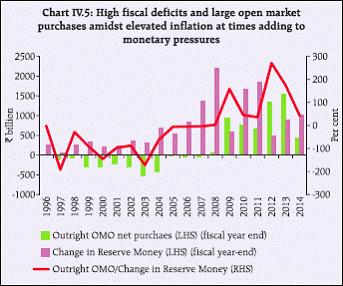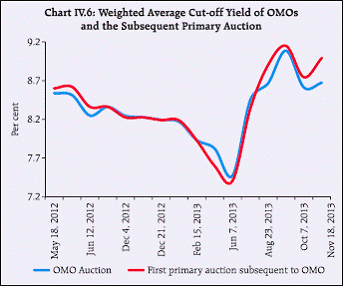 IST,
IST,
Chapter IV : Addressing Impediments to Transmission of Monetary Policy
1. Introduction IV.1 The efficacy of monetary policy actions lies in the speed and magnitude with which they achieve the final objectives. With the deepening of financial systems and growing sophistication of financial markets, most monetary authorities are increasingly using indirect instruments (such as policy interest rates and open market operations) rather than direct measures (like credit allocation). Adjustments in the policy interest rate, for instance, directly affect shortterm money market rates which then transmit the policy impulse to the fuller spectrum of interest rates in the financial system, including deposit and lending rates, that in turn affect consumption, saving and investment decisions of economic agents and eventually aggregate demand, output and inflation. The interest rate channel of transmission has become the cornerstone of monetary policy in most countries. This channel may also operate through expectations of future interest rates, and thereby influence the behaviour of economic agents in an economy in a forward looking manner. IV.2 Underdeveloped and incompletely integrated market segments inhibit the transmission of monetary policy through the interest rate channel. Accordingly, some central banks operate by directly altering reserve requirements alone or in conjunction with the policy interest rate to affect the availability and price of credit. IV.3 The transmission mechanism is characterised by long, variable and uncertain time lags, making it difficult to predict the precise effect of monetary policy actions on the economy. Apart from differential lags, there are also asymmetries involved in the quantitative responses of the policy impulse to the goal variables in alternate phases of the business cycle and liquidity conditions. It is generally accepted in the literature that monetary policy has limited effects on aggregate supply or productive capacity, though in the presence of credit constraints, the ability of firms to expand capacities is impacted, thus affecting aggregate supply1. 2. International Experience IV.4 Monetary transmission in advanced economies occurs through several alternative channels, and is generally found to be robust and efficient in normal times. In contrast, in emerging market economies (EMEs), it is the credit channel that dominates transmission2. 2.1. Interest rate channel IV.5 In the case of advanced economies (AEs), the interest rate channel works by impacting the cost of capital. It has been found to be strong and has exhibited good information content about future movement of real macroeconomic variables (Bernanke and Blinder, 1992)3. In the case of EMEs, which do not have well-functioning capital markets for debt and equities, and in which real estate markets are fragmented and illiquid, monetary transmission through the interest rate has been found to be weak. Furthermore, the interest rate channel is also dulled during surges in capital inflows. On an average across Asian economies, the pass-through coefficients for transmission from policy rates to lending rates declined by about 30-40 basis points during episodes of capital inflows, but were still about 0.3-0.6 (Jain- Chandra and Unsal, 2012)4. Transmission from policy rates to money market rates and retail lending rates is found to be strong in transition economies of Europe, but the transmission to longer maturity rates is rather weak (Égert and MacDonald, 2009)5. However, recent evidence suggests that the interest rate channel is strengthening in many EMEs, including India6. This is attributed, inter alia, to reduced fiscal dominance, more flexible exchange rates and development of market segments (Gumata et al., 2013)7. 2.2. Credit Channel IV.6 Empirical evidence supports the existence of the credit channel of transmission. This operates by affecting the external finance premium through both the bank lending channel (by decreasing the supply of bank loans in response to contractionary monetary policy) and the balance sheet channel (contractionary monetary policy decreases collateral valuation and net worth of firms, raises agency costs and affects firms’ activity levels through the financial accelerator). Recent evidence from the euro area suggests that the bank lending channel was more pronounced than the balance sheet channel in the case of firms, while for households, it was the other way round (Cicarrelli, et al, 2010)8. The bank lending channel is also found to have a larger impact on banks that are small, less capitalised and less liquid. Some evidence suggests that firms substitute trade credit for bank loans at times of monetary contraction, thus weakening the credit channel. This is particularly the case for EMEs. In the case of Sub-Saharan Africa, excluding South Africa, the bank lending channel has been found to work feebly, given that informal finance dominates credit markets and the penetration of institutional finance is limited, given the low competition from the banking sector. However, in the case of many EMEs, especially where bank-oriented financial systems exist, the credit channel is strong. While informal finance weakens monetary transmission, experience suggests that transmission through the credit channel is strong in the case of micro-finance institutions (MFIs). 2.3. Exchange Rate Channel IV.7 An important channel of monetary transmission has been the exchange rate that is either directly influenced by the central bank or gets impacted by its actions. Typically, the exchange rate channel works through expenditure switching between domestic and foreign goods. For instance, an appreciation of the domestic currency makes foreign goods cheaper causing demand for domestic goods and net exports to fall. However, this may also reduce external debt in domestic currency terms. Both effects transmit to aggregate demand and the price level. Empirical evidence suggests that the exchange rate channel is strong in economies with freely floating exchange rates, but its impact is dampened with central bank intervention. For instance, in the case of Latin American countries, lower exchange rate flexibility relative to peers in Asia seems to have resulted in weaker transmission of policy rates. 2.4. Asset Price Channel IV.8 Apart from exchange rates, changes in other asset prices such as equities and house prices also impact inflation and growth. Equity prices are dampened in response to contractionary monetary policy and the resultant wealth effects and collateral valuation changes feed through to consumption and investment. The asset price channel is quite weak in many EMEs where equity markets are small and illiquid, but relatively strong in countries that have open equity markets. Transmission is also found to be limited in countries with weak property price regimes and poorly developed and illiquid real estate markets. In countries like the US and Australia, where the mortgage market is well integrated with capital markets, the asset price channel turns out to be quite strong. In general, stock prices respond faster to contractionary monetary policy, though the intensity and lags of transmission are impacted by the liquidity in the stock markets. 2.5. Transmission Lags IV.9 Time lags in transmission are usually long, variable and tend to differ from one country to another owing to differences in economic and market structures. They also vary over time due to dynamically changing macroeconomic and financial conditions. For instance, these lags are found to vary from 1-14 quarters for transmission of policy rates to output across a gamut of advanced and emerging economies with varied monetary arrangements. While transmission is weaker in case of EMEs, it is not clear if the transmission lags are longer. In fact, some recent evidence suggests longer lags for AEs relative to EMEs – for instance, average lag of 33.5 months for all countries; 42 months in the case of the US, 48 months for the euro area, and in the range of 10-19 months for transition economies that became new EU members (Havránek and Rusnák, 2012)9. For Brazil, the monetary policy transmission through the aggregate demand channel takes between 6 and 9 months: the interest rate affects consumer durables and investment in between 3 to 6 months and the output gap takes an additional 3 months to have a significant impact on inflation (Bogdanski et.al., 2000)10,11. 3. Sensitivity of Inflation and Output to Monetary Policy in India IV.10 Empirical evidence indicates that monetary transmission in India has been taking place through several channels (RBI, 2005; Patra and Kapur, 2010; Mohanty, 2012; Khundrakapam and Jain, 2012; Khundrakapam, 2011; Kapur and Behera, 2012; Singh, 2011 and Keltzer, 2012)12. The broad consensus emerging from these studies is that monetary policy in India impacts output with a lag of about 2-3 quarters and WPI headline inflation with a lag of about 3-4 quarters and the impact persists for 8-12 quarters. Among the channels of transmission, the interest rate has been found to be the strongest. In view of the Committee’s choice of inflation as the nominal anchor for monetary policy in India, this section primarily focuses on empirical evaluation of the transmission of monetary policy signals to inflation. 3.1. Interest Rate Channel IV.11 Monetary policy interest rate movements have been found to share a co-integrating relationship with rates across different segments of financial markets. Results of block exogeneity tests show that there exists bi-directional causality between call money rates and interest rates in other segments such as the government debt market, credit market or returns on equity market and the forex market13. Medium to long term rates such as bank deposit and lending rates exhibit asymmetrical responses to policy rate changes under varied market conditions, responding faster with relatively larger responses in liquidity deficit conditions than in surplus conditions. Furthermore, lending rates for certain sectors such as housing and automobiles respond relatively faster to policy rate changes compared with other sectors. 3.2. Credit Channel IV.12 India is a bank-dominated economy, even though in recent years the role of equity and debt markets as sources of financing of economic activities has increased. The share of banks in domestic corporate borrowing has remained high (Chart IV.1). High-dependence on bank finance makes the bank lending and the balance sheet channels particularly important for monetary transmission, which is also evidenced through Granger causality tests14. In terms of balance sheet effects, credit growth is seen to have an inverse relationship with movements in the policy rate15. 3.3. Exchange Rate Channel IV.13 The exchange rate channel is found to be feeble in India with some evidence of weak exogeneity16. While changes in policy interest rates may influence movements in exchange rates, the level of the exchange rate is not a policy goal, as the RBI does not target any level or band of the exchange rate. Exchange rate depreciation is a key source of risk to inflation as the estimated pass-through coefficients for India suggest (Table IV.1).
3.4. Asset Price Channel IV.14 Empirical evidence for India indicates that asset prices, especially stock prices, react to interest rate changes, but the magnitude of the impact is small (Singh and Pattanaik 2012)24. Moreover, the wealth effect of increasing equity prices in the Indian case is found to be limited (Singh, 2012)25. With the increasing use of formal finance (from banks and non-banks) for acquisition of real estate, the asset price channel of transmission has improved. However, during periods of high inflation, there is a tendency for households to shift away from financial savings to other forms of savings such as gold and real estate that tend to provide a better hedge against inflation. To the extent that these acquisitions are funded from informal sources, they may respond less to contractionary monetary policy, thus weakening the asset price channel in India. 4. Identifying Impediments to Transmission IV.15 In India, financial sector reforms and progressive deregulation of the financial sector created pre-conditions for conducting monetary policy primarily through changes in the interest rate as the main policy instrument. The effectiveness of monetary policy, however, remains constrained by several country-specific factors that affect transmission of the policy impulses through the interest rate channel. Some of the major factors are briefly explained below. 4.1. Sustained Fiscal Dominance IV.16 Despite phasing out of the Reserve Bank’s participation in primary issuances of Government securities (G-secs), fiscal dominance continues to impinge on monetary policy efficacy as open market operations are intermittently deployed to ‘manage yields’ in the face of large government borrowings. Data for the past decade show that whenever the net market borrowing of the government has increased, the ratio of incremental investment by banks in government securities has gone up, leading to lower share of non-food credit in bank finance, i.e., pointing to crowding out of the private sector (Chart IV.2). i. Statutory Pre-emption through SLR IV.17 Large government market borrowing has been supported by regulatory prescriptions under which most financial institutions in India, including banks, are statutorily required to invest a certain portion of their specified liabilities in government securities and/or maintain a statutory liquidity ratio (SLR) (Table IV.2). IV.18 The SLR prescription provides a captive market for government securities and helps to artificially suppress the cost of borrowing for the Government, dampening the transmission of interest rate changes across the term structure. It is also observed that the Government often borrows at a negative real interest rate, especially in recent years (Chart IV.3). While banks generally invest in government securities above the statutory prescription since excess SLR securities serve as the only collateral for availing central bank resources under the LAF (Table IV.3), a lower SLR prescription, ceteris paribus, is likely to decrease banks’ investments in G-secs. ii. Small Savings Schemes IV.19 Besides market borrowings, the other main source of funding government deficits in India is small savings mobilised through, inter alia, post office deposits, saving certificates and the public provident fund, characterised by administered interest rates and tax concessions. The interest rates on small savings were earlier changed infrequently26. Consequently, small savings in the past had acquired a competitive edge over bank deposits during the easing phase of monetary policy, as was evident during 2009-10 (Chart IV.4). The resultant substitution from bank deposits to small savings eroded the effectiveness of the monetary transmission mechanism, especially the bank lending channel. To some degree, the annual reset for the small savings rates continues to provide them a competitive edge. Therefore, the option of a half-yearly or quarterly reset should be implemented.
iii. Subventions IV.20 The Government also influences the monetary policy transmission channel through its directives to banks. Keeping some economically and socially important objectives in mind, both the Central and State Governments offer interest rate subvention to certain sectors, including agriculture (Table IV.4). There have also been non-interest subventions, such as the Agricultural Debt Waiver and Debt Relief Scheme in 2008. iv. Taxation IV.21 The tax advantage for the fixed maturity plans (FMPs) of the debt Mutual Funds of tenors of a year or more against fixed deposits of corresponding maturities also weakens the credit channel of monetary transmission. Similarly, to the extent the financial products of non-banks are not subjected to tax deduction at source, they have an advantage over bank deposits and weaken the transmission on the same grounds. Recommendations IV.22 In order to address specific impediments to monetary policy transmission in India, the Committee recommends the following: (a) Consistent with the time path of fiscal consolidation mentioned in Chapter II, SLR should be reduced to a level in consonance with the requirements of liquidity coverage ratio (LCR) prescribed under the Basel III framework. (b) Government should eschew suasion and directives to banks on interest rates that run counter to monetary policy actions. (c) More frequent intra-year resets of interest rates on small saving instruments, with built-in automaticity linked to benchmark G-sec yields, need to be brought in. Also, the benchmark should be based on average of the previous six months or even shorter intervals so as to better capture changes in interest rate cycles within a year. (d) All fixed income financial products should be treated on par with bank deposits for the purpose of taxation and TDS. Further, the tax treatment of FMPs and bank deposits should also be harmonised . (e) With a sharp rise in the ratio of agricultural credit to agricultural GDP, the need for subventions on interest rate for lending to certain sectors would need to be re-visited27. 4.2. Large Informal Sector and Still Significant Presence of Informal Finance IV.23 Despite the growing reach of the formal banking and non-banking network, informal finance still caters to the financing requirements of the major part of India’s population28. The recourse to noninstitutional sources is relatively high, both in rural and urban areas, particularly by lower income groups. Also, the cost of borrowing from informal/semi-formal sources is significantly higher than that of borrowing from banks (Table IV.5). High cost itself may be an impediment to transmission, particularly when incremental changes in the policy rate constitute only a small fraction of the overall funding costs. Thus, the significant presence of informal finance as well as its costs of intermediation can impede the impact of monetary policy on aggregate demand.
4.3. Financial and Credit Market Frictions, Bank Behaviour and Monetary Policy IV.24 There are certain facets of monetary policy that interface with credit and financial markets. In this context, market frictions and/or the endogenous response of the RBI to liquidity demand weaken monetary transmission. IV.25 First, on the lending side, banks determine their interest rates with reference to the base rate. While banks are free to decide their base rates, they are required to take into consideration factors like cost of funds, adjustment for the negative carry in respect of CRR and SLR, overhead cost and a profit margin. The policy repo rate does not directly affect the determination of base rate of banks, except at the margin where wholesale funding is used. Even this role has greatly diminished, since wholesale funding (including borrowing from the Reserve Bank) constitute barely 10 per cent of the total funds raised by banks (Table IV.6). IV.26 Secondly, with regard to deposits, while interest rates are re-priced when policy rates increase, this is only at the margin. A more complete transmission is impeded by the maturity pattern being largely concentrated in fixed tenor deposits (Table IV.7). Moreover, the distribution of term deposits is tilted in favour of longer duration (i.e., one year and above) deposits (Table IV.8). These fixed rate deposits, together with the pursuit of inflexible net interest margins by public sector banks, imparts rigidity to the entire interest rate structure. Going forward, increase in competition as suggested by the Reserve Bank is necessary to impart greater dynamism and flexibility to the banking structure and associated outcomes (RBI, 2013)29. IV.27 Thirdly, the transmission of monetary policy to deposit and lending rates is sensitive to liquidity conditions prevailing at the time of a policy rate change and during the period thereafter. As shown in Table IV.9, cumulative increase of 175 bps in the repo rate in 2011-12 was transmitted to both deposit and lending rates, albeit less than proportionately. In 2012-13, however, the repo rate was cut by 100 bps, but despite the cut in CRR by 75 bps, deposit and lending rates did not soften much due to deficit and occasionally tight liquidity conditions. In 2013-14 (so far), the cumulative increase in repo rate has been 25 bps, but in the absence of any CRR cuts and because of the policy induced tightness in liquidity conditions, transmission to the modal deposit rate has been higher than the change in the policy rate30. Empirical research for India corroborates the role of liquidity conditions in impacting the transmission – “monetary policy transmission is more effective during the liquidity deficit mode as compared to the surplus mode” (Ray and Prabhu, 2013)31. Significant asymmetry is observed in the transmission of policy rate changes between the surplus and deficit liquidity conditions, suggesting that maintaining suitable liquidity environment is critical to yielding improved passthrough (Singh, 2011,op. cit.). Recommendations IV.28 Unless the cost of banks’ liabilities moves in line with the policy rates as do interest rates in money market and debt market segments, it will be difficult to persuade banks to price their loans in response to policy rate changes. Hence, it is necessary to develop a culture of establishing external benchmarks for setting interest rates based on which financial products can be priced. Ideally, these benchmarks should emerge from market practices. However, the Committee is of the view that the Reserve Bank could explore whether it can play a more active supportive role in its emergence. IV.29 The RBI’s liquidity management operations should strive to ensure consistency with the stance of monetary policy. Accordingly, an increase in the policy rate to convey an anti-inflation policy stance should be accompanied by tightening of liquidity conditions through liquidity management operations, whereas an easing of the policy stance should be associated with accommodative liquidity conditions. IV.30 The Committee is also of the view that there should be close coordination between the settings of monetary policy and macro-prudential policies, since variations in macro-prudential instruments such as capital buffers, provisions, loan-to-value ratios and the like impacts the cost structures and lendable resources of banks, thereby impacting monetary transmission. 4.4. Other Aspects of Monetary Policy Transmission i. High Inflation and Financial Disintermediation IV.31 High inflation in itself impedes transmission of monetary policy. This impact is exacerbated if interest rates on financial products do not adjust to inflation and yield negative returns. In India, gold and real estate compete with deposits, thereby constraining the degree of flexibility available to banks, particularly in lowering the deposit rates (given the fear of loss of deposits) in an easing phase of monetary policy. For four consecutive years between 2009-10 and 2012- 13, average deposit rates remained below the CPI inflation for those years, whereas the annual return from gold and real estate exceeded CPI inflation most of the times, and by a significant margin as well (Table IV.10). With the annual average consumer price inflation touching double digits or staying just underneath for the last six years, bank deposits have been yielding negative returns in real terms. ii. Endogenous Liquidity Under the Monetary Policy Framework IV.32 Under the extant monetary policy framework, financing of large fiscal deficits through market borrowings has effectively resulted in the use of open market operations (OMO) primarily to smoothen G-sec yields rather than being employed as a pure monetary policy tool, contrary to cross-country practices which have increasingly favoured the separation of debt management operations from liquidity management (Table IV.11). In India, on the other hand, transmission has been impeded by: (a) not enforcing enough liquidity management discipline in the banking system; and (b) allowing excessive indirect monetisation of the fiscal deficit which also undermines the credibility of discretionary liquidity management operations. The LAF framework allows banks complete freedom to access liquidity from the RBI at the repo rate, up to their excess SLR holdings. The cost of holding excess SLR gets reflected in the pricing of other assets. IV.33 As government market borrowing crowds out funds to the private sector, in turn placing pressure on liquidity, the central bank is often forced to accommodate the resultant liquidity shortages by providing additional liquidity through open market operations, especially via outright purchases of G-secs. The net market borrowings of the central Government have increased 10-fold in the eight years till 2012-13, even without counting for additional funding of `1.16 trillion through 364-day treasury bills during the terminal year. Even in 2010-11, when monetary policy needed to be tightened aggressively and efforts were being made in that direction, large OMO purchases were effected. Reflecting these developments, OMO transactions have largely become one-sided in recent years and have turned into a dominant source of reserve money creation rather than a tool for managing liquidity mismatches (Chart IV.5). While some expansion of reserve money consistent with the growth in broad money and nominal GDP is necessary (as set out under Pillar II in Chapter III), excessive monetary expansion at times results from indirect monetisation of the fiscal deficit through OMOs. IV.34 When the OMO cut-off yields in a given auction are lower than the cut-off yield in the immediately following primary auction of G-secs (Chart IV.6, Table IV.12), it creates opportunities for the banking system to profit from the RBI’s liquidity management operations. In 2012-13, in effect, 30 per cent of the net borrowing requirement of the Government was supported through OMOs (Table IV.13). Recommendations IV.35 Accordingly, the Committee recommends that OMOs have to be detached from fiscal operations and instead linked solely to liquidity management. OMOs should not be used for managing yields on government securities. IV.36 To sum up, there are several impediments that need to be taken on board for effective monetary transmission, some of which can be addressed through steps taken by the Reserve Bank itself. First and foremost, OMO purchases should be undertaken only when the liquidity condition warrants them. Second, the Reserve Bank should continue its efforts to develop the term repo market by calibrating liquidity at its overnight repo window as necessary. Third, the Reserve Bank should avoid regulatory forbearance, especially by changing norms for portfolio classification when yields rise. Fourth, it should facilitate a more competitive and dynamic banking structure so that re-pricing of deposit and lending rates, in due course, becomes faster in response to RBI’s monetary policy actions. 1Against the backdrop of the recent financial crisis, some preliminary evidence suggests that the damage to productive capacity in the US was an endogenous response to weak aggregate demand (Reifschneider, D., W. L. Wascher and D. Wilcox, (2013): “Aggregate Supply in the United States: Recent Developments and Implications for the Conduct of Monetary Policy”, 14th Jacques Polak Annual Research Conference, IMF, Washington). 2Mishra, P. and P. Montiel (2012), “How Effective is Monetary Transmission in Low Income Countries? A Survey of Empirical Evidence”, IMF Working Paper, No. WP/12/143, June. 3Bernanke, B., S. and A. S. Blinder (1992), “The Federal Funds Rate and the Channel of Monetary Transmission”, The American Economic Review, 82(4): 901-21. 4Jain-Chandra, S. and D. F. Unsal (2012): “The Effectiveness of Monetary Policy Transmission Under Capital Inflows: Evidence from Asia”, IMF Working Paper No. WP/12/265. 5Égert, B. and R. MacDonald (2009): “Monetary Transmission Mechanism in Central and Eastern Europe: Surveying the Surveyable”, Journal of Economic Surveys, 23(2): 277-327. 6Mohanty, M.S. and P. Turner (2008): “Monetary Policy Transmission in Emerging Market Economies: What is New?”, BIS Policy Paper No.3, January. 7Gumata, N., A Kabundi and E. Ndou (2013): “Important channels of transmission of monetary policy shock in South Africa”, ERSA Working Paper No. 375, Cape Town. 8Cicarelli, M., A. Maddaloni and J. L. Peydro (2010): “Trusting the Bankers: A New Look at the Credit Channel of Monetary Policy”, ECB Working Paper No.1228 . 9Havránek, T. and M. Rusnák (2012): “Transmisson Lags in Monetary Policy: A Meta Analysis”, Czech National Bank Working Paper Series, No.10. 10Bogdanski, J., A. A. Tombini and S. R. C. Werlang (2000): “Implementing Inflation Targeting in Brazil”, Working Paper Series No.1, Banco Central do Brasil. 11However, transmission lags in cross-country studies may not be strictly comparable as they depend on the size and timing of the policy actions. 12Kapur, M. and H. Behera (2012): “Monetary Transmission Mechanism in India: A Quarterly Model”, RBI Working Paper No. 9.
13Following Singh (2011) and Mohanty (2012), Granger’s causality across markets based on a VAR framework was examined using monthly data from April 2001 to March 2013. Two blocks were considered, viz., (i) policy variable – proxied by monthly average Call Money Rate (CMR) and (ii) other financial market variables. The latter include yield on government securities with residual maturity of 10-years and yield on the 5-year ‘AAA’ rated corporate bonds representing debt market, weighted average lending rate (WALR) indicating credit market, BSE Sensex showing equity market, and Rupee per US dollar representing foreign exchange market. The test was repeated by replacing 5-year ‘AAA’ rated corporate bond by the yield of the 10-year ‘AAA’ rated corporate bonds and results were similar. 14
15Recent work, i.e., Pandit and Vashisht (2011) #, Khundrakpam (2011) and Khundrakpam and Jain (2012) also corroborated the existence of a robust and statistically significant credit channel of monetary transmission in the post-LAF period. According to Khundrakpam (2011), a 100 basis points increase in policy rate reduced the annualised growth in nominal and real bank credit by 2.78 per cent and 2.17 per cent, respectively. #Pandit, B.L. and P. Vashisht (2011), “Monetary Policy and Credit Demand in India and Some EMEs”, Indian Council for Research on International Economic Relations, Working Paper No.256. 16Ray, P., H. Joshi and M. Saggar (1998): “New Monetary Transmission Channels: Role of Interest Rate and Exchange Rate in the Conduct of Monetary Policy”, Economic and Political Weekly, 33(44), 2787-94. 17Khundrakpam, J. K. (2007): “Economic reforms and exchange rate pass-through to domestic prices in India”BIS Working Papers 225, Bank for International Settlements. 18Kapur, M. (2012): “Inflation Forecasting: Issues and Challenges”, RBI Working Paper No. 1. 19Kapur, M. and H. Behera (2012): “Monetary Transmission Mechanism in India: A Quarterly Model”, RBI Working Paper No.9. 20Patra, M.D., and M. Kapur (2010), “A monetary policy model without money for India”, IMF Working Paper No.10/183, International Monetary Fund. 21Patra, M.D., J.K. Khundrakpam, and A.T. George (2013): “Post-Global Crisis Inflation Dynamics in India What has Changed?”, Paper presented at the India Policy Forum, July 16-17. 22Ghosh, A. and R. Rajan (2007): “Macroeconomic Determinants of Exchange Rate Pass-Through in India”, April. Available at SSRN: http://dx.doi. org/10.2139/ssrn.984332 23Bhattacharya, R., Patnaik, I., & Shah, A. (2008), ‘Exchange rate pass-through in India’, Macro/Finance Group at NIPFP,[Online]. Available at: 24Singh, B. and S. Pattanaik (2012): “Monetary Policy and Asset Price Interactions in India: Should Financial Stability Concerns from Asset Prices be Addressed Through Monetary Policy?”, Journal of Economic Integration, Vol. 27,167-194. 25Singh, B. (2012): “How important is the stock market wealth effect on consumption in India?”, Empirical Economics, 43(3), 915-927. 26Pursuant to the recommendations of the Committee on Comprehensive Review of National Small Savings Fund (Report submitted in June 2011), the government announced in November 2011 the alignment of the rate of interest on small savings schemes with interest rates on government securities of similar maturity with a spread of 25 basis points. It was also decided that the notification of interest rate on small savings schemes for every financial year would be before the year commenced. Nonetheless, some rigidities still remain in the interest rates on small savings instruments. This is because the benchmark yield is an average of the month-end yields of the previous financial year. Also the interest rate stays fixed for the year. These rigidities continue to pose impediments to transmission. 27The ratio of outstanding agriculture loans to agriculture GDP increased from 9.5 per cent in the 1990s to 12.2 per cent in 2001-02, but subsequently rose sharply to 35.9 per cent in 2012-13. 28According to the World Bank Findex Survey (2012), only 35 per cent of Indian adults have access to a formal bank account and 8 per cent borrowed formally in the last 12 months. Only 2 per cent of adults used an account to receive money from a family member living in another area and 4 per cent used an account to receive payment from the Government. 29RBI (2013): Discussion Paper on ‘Banking Structure in India - The Way Forward’, available on 30Since deposit and lending rates may respond with different lags when the repo rate is changed, and given that liquidity is only one of the many determinants of transmission, direct comparison of deposit and lending rates relative to prevailing liquidity conditions may only provide broad indications of the link between liquidity conditions and transmission. 31Ray, P. and E.Prabhu (2013), “Financial Development and Monetary Policy Transmission Across Financial Markets: What Do Daily Data tell for India?”, RBI Working Paper,No. 4. |
||||||||||||||||||||||||||||||||||||||||||||||||||||||||||||||||||||||||||||||||||||






